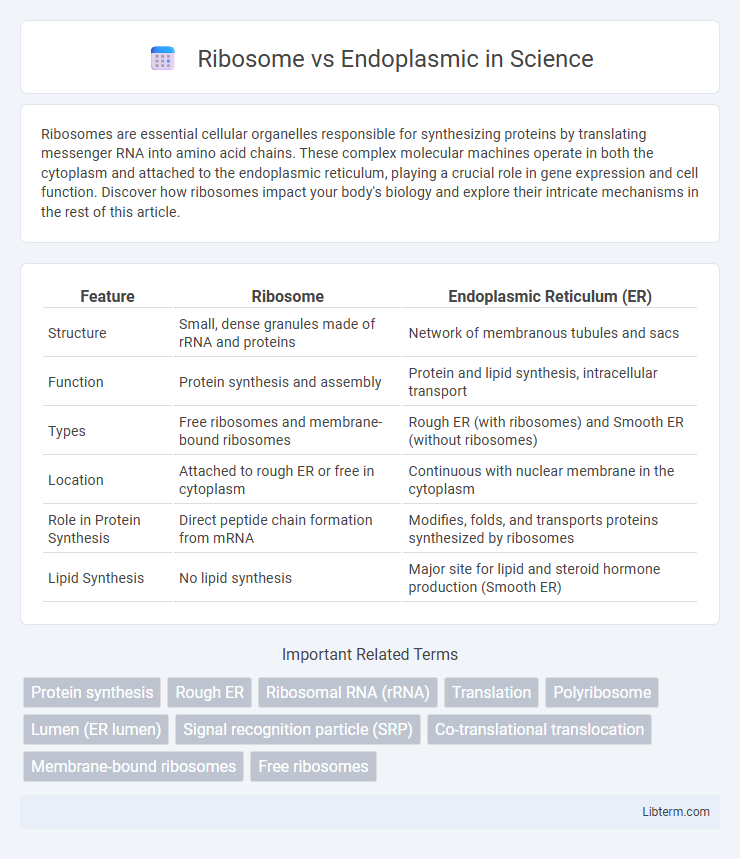Ribosomes are essential cellular organelles responsible for synthesizing proteins by translating messenger RNA into amino acid chains. These complex molecular machines operate in both the cytoplasm and attached to the endoplasmic reticulum, playing a crucial role in gene expression and cell function. Discover how ribosomes impact your body's biology and explore their intricate mechanisms in the rest of this article.
Table of Comparison
| Feature | Ribosome | Endoplasmic Reticulum (ER) |
|---|---|---|
| Structure | Small, dense granules made of rRNA and proteins | Network of membranous tubules and sacs |
| Function | Protein synthesis and assembly | Protein and lipid synthesis, intracellular transport |
| Types | Free ribosomes and membrane-bound ribosomes | Rough ER (with ribosomes) and Smooth ER (without ribosomes) |
| Location | Attached to rough ER or free in cytoplasm | Continuous with nuclear membrane in the cytoplasm |
| Role in Protein Synthesis | Direct peptide chain formation from mRNA | Modifies, folds, and transports proteins synthesized by ribosomes |
| Lipid Synthesis | No lipid synthesis | Major site for lipid and steroid hormone production (Smooth ER) |
Introduction to Ribosomes and Endoplasmic Reticulum
Ribosomes are molecular machines responsible for synthesizing proteins by translating messenger RNA sequences into amino acid chains, found either freely in the cytoplasm or attached to the rough endoplasmic reticulum (ER). The endoplasmic reticulum, a complex membranous network, exists in two forms: rough ER, studded with ribosomes and involved in protein synthesis and folding, and smooth ER, which participates in lipid metabolism and detoxification processes. Together, ribosomes and the endoplasmic reticulum coordinate cellular protein production and processing, essential for maintaining cellular function and homeostasis.
Structural Differences: Ribosome vs Endoplasmic Reticulum
Ribosomes are small, spherical complexes of RNA and protein responsible for protein synthesis, lacking membrane structures and often found floating freely in the cytoplasm or attached to the rough endoplasmic reticulum (ER). The endoplasmic reticulum, a membranous organelle, exists in two forms: rough ER, studded with ribosomes on its cytoplasmic surface, and smooth ER, which is devoid of ribosomes and involved in lipid synthesis and detoxification. Structurally, ribosomes are discrete particles approximately 20-30 nm in diameter, while the endoplasmic reticulum is an extensive network of flattened tubules and sacs that provide a large surface area for biochemical processes.
Types of Ribosomes and Endoplasmic Reticulum
Ribosomes exist in two main types: free ribosomes, which synthesize proteins for use within the cytoplasm, and bound ribosomes, which attach to the rough endoplasmic reticulum (RER) and produce proteins destined for secretion or membrane insertion. The endoplasmic reticulum (ER) is categorized into rough ER, studded with ribosomes for protein synthesis, and smooth ER, which lacks ribosomes and functions in lipid synthesis and detoxification. This structural and functional differentiation enables the cell to efficiently manage protein production and lipid metabolism.
Location within the Cell: Ribosome vs Endoplasmic Reticulum
Ribosomes are either freely floating in the cytoplasm or attached to the rough endoplasmic reticulum (ER), facilitating protein synthesis. The endoplasmic reticulum is an extensive membrane network found throughout the cytoplasm, with the rough ER studded with ribosomes and the smooth ER lacking them. This spatial arrangement enables the rough ER to synthesize and fold proteins, while free ribosomes produce proteins destined for the cytosol.
Functional Roles in Protein Synthesis
Ribosomes serve as the primary sites for translating mRNA into polypeptide chains, directly synthesizing proteins by linking amino acids in sequence. The rough endoplasmic reticulum (RER) supports ribosomes by providing a membrane-bound environment where nascent proteins undergo folding, modification, and transport. Together, ribosomes and the RER coordinate to ensure efficient protein synthesis, processing, and targeting within eukaryotic cells.
Ribosome and Endoplasmic Reticulum: Key Molecular Components
Ribosomes, composed primarily of ribosomal RNA and proteins, serve as the molecular machines responsible for synthesizing polypeptides by translating messenger RNA. The endoplasmic reticulum (ER) consists of a membrane network subdivided into rough ER, studded with ribosomes for protein synthesis, and smooth ER, involved in lipid metabolism and detoxification processes. Integral to cellular function, the rough ER provides a structural platform facilitating co-translational insertion of nascent polypeptides into the ER lumen for folding and modification.
Interactions between Ribosomes and Endoplasmic Reticulum
Ribosomes attach to the rough endoplasmic reticulum (ER) membrane where they synthesize proteins destined for secretion or membrane insertion. This interaction ensures proteins are translocated directly into the ER lumen for proper folding and post-translational modifications. The close association between ribosomes and the rough ER facilitates efficient protein targeting and cellular compartmentalization.
Importance in Cellular Metabolism
Ribosomes are essential for cellular metabolism by synthesizing proteins necessary for enzymatic activities and structural functions. The endoplasmic reticulum (ER), particularly the rough ER, supports metabolism by providing a platform for ribosome attachment and facilitating protein folding and modification. Both organelles collaborate to ensure efficient protein production and metabolic regulation within the cell.
Impact of Ribosome and Endoplasmic Reticulum Malfunctions
Malfunctions in ribosomes disrupt protein synthesis, leading to cellular dysfunction and diseases such as Diamond-Blackfan anemia and certain cancers. Endoplasmic reticulum (ER) malfunctions cause protein misfolding and ER stress, which are linked to neurodegenerative disorders like Alzheimer's and Parkinson's disease. Both organelle impairments compromise cellular homeostasis and contribute to metabolic and genetic conditions.
Comparing Ribosome vs Endoplasmic Reticulum: Summary Table
Ribosomes are small, dense structures responsible for protein synthesis, found either floating freely in the cytoplasm or attached to the rough endoplasmic reticulum (ER), whereas the endoplasmic reticulum is a membranous organelle involved in protein and lipid synthesis, with rough ER studded with ribosomes and smooth ER lacking ribosomes. The ribosome's main function is translating mRNA into polypeptides, while the rough ER processes and folds these proteins, and the smooth ER synthesizes lipids and detoxifies chemicals. Structurally, ribosomes consist of RNA and proteins without a membrane, contrasting with the ER's extensive membrane network critical for intracellular transport and metabolic functions.
Ribosome Infographic

 libterm.com
libterm.com